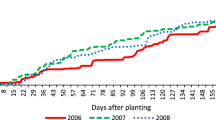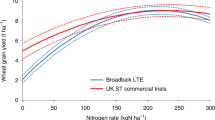Abstract
Crop growth models including CERES-Maize and CROPGRO-Soybean have been used in the past to evaluate causes of spatial yield variability and to evaluate economic consequences of variable rate prescriptions. In this work, a nitrogen prescription program has been developed that simulates the consequences of different nitrogen prescriptions using the DSSAT crop growth models. The objective of this paper is to describe a site-specific nitrogen prescription and economic optimizer program developed for computing spatially optimum N rates over long periods of weather and plant population for maize (Zea mays L.) using the CERES-Maize model. The application of the model was demonstrated on a field in Germany and another one in the USA to evaluate the concept across different environmental conditions. The user can determine the short- and the long-term optimal spatial nitrogen prescription based on crop price and nitrogen cost. The program simulated short-term optimum N applications that averaged 9% (McGarvey field, USA) and 48% (Riech field, Germany) lower than the uniform rates actually applied in the fields. The program indicated different site-specific N management options for low and high yielding fields under the assumed prices for maize and N. The implementation of a site-specific plant population management was investigated. A site-specific-optimization of plant population showed a higher profitability in the heterogeneous field in Germany. Hard pan depth, hard pan factor, root distribution factor and the percentage of available soil water across the heterogeneous field were useful indicators in predicting the magnitude of site-specific plant population benefits over uniform rates.





Similar content being viewed by others
References
Batchelor, W. D., Paz, J. O., & Thorp, K. R. (2004). Development and evaluation of a decision support system for precision agriculture. In Proceedings of the 7th international conference on precision agriculture. Madison, WI, USA: ASA–CSSA–SSSA (CDROM).
Duncan, W. G. (1958). The relationship between corn population and yield. Agronomy Journal, 50, 82–84.
FAOSTAT. (2014). Statistical database of the Food and Agriculture Organization (FAO) of the United Nations. Retrieved August 2018, from http://www.fao.org/faostat/en/#country/.
QGIS Development Team. (2009). QGIS geographic information system. Open Source Geospatial Foundation. Retrieved August 2018, from https://plugins.qgis.org/plugins/geospatialsimulation/.
Jones, J. W., Hoogenboom, G. J., Porter, C., Boote, K. J., Batchelor, W. D., Hunt, L. A., et al. (2003). DSSAT cropping system model. Special Edition of European Journal of Agronomy, 18, 235–265.
Link, E. J., Graeff, S., & Batchelor, W. D. (2008). Evaluation of current and model-based site-specific nitrogen applications on wheat (Triticum aestivum L.) yield and environmental quality. Precision Agriculture, 9, 251–267.
Link, E. J., Graeff, S., Batchelor, W. D., & Claupein, W. (2006). Evaluating the economic and environmental impact of a German compensation payment policy under uniform and variable-rate nitrogen management strategies using a crop model. Agricultural Systems, 91, 135–153.
Link, E. J., Graeff, S. S., & Claupein, W. (2013). Comparison of uniform control and site-specific model-based nitrogen prescription in term of grain yield, nitrogen efficiency and economic aspects in a heterogeneous corn field. Journal of Cultivated Plants, 65(6), 236–247.
Miao, Y., Mulla, D. J., Batchelor, W. D., Paz, J. O., & Robert, P. C. (2006). Evaluating management zone optimal N rates with a crop growth model. Agronomy Journal, 98(3), 545–553.
Olson, R. A., & Sanders, D. H. (1988). Maize production. In G. F. Spraggue & J. W. Dudley (Eds.), Corn and corn improvement (pp. 639–686). Madison, WI, USA: American Society of Agronomy.
Paz, J. O., Batchelor, W. D., Colvin, T. S., Logsdon, S. D., Kaspar, T. C., Karlen, D. L., et al. (1999). Model-based techniques to determine variable rate nitrogen for corn. Agricultural Systems, 60, 69–75.
Paz, J. O., Batchelor, W. D., & Tylka, G. L. (2001). Method to use crop growth models to estimate potential return for variable-rate management in soybeans. Transactions of the ASAE, 44(5), 1335–1341.
Tetio-Kagho, F., & Gardner, F. P. (1988). Response of maize to plant population density: II. Reproductive development, yield and yield adjustment. Agronomy Journal, 80, 935–940.
Thorp, K. R., Batchelor, W. D., Paz, J. O., Steward, B. L., & Caragea, P. C. (2006). Methodology to link production and environmental risks of precision nitrogen management strategies in corn. Agricultural Systems, 89(2–3), 272–298.
Thorp, K. R., & Bronson, K. (2013). A model-independent open-source geospatial tool for managing point-based environmental model simulations at multiple spatial locations. Environmental Modeling and Software, 50, 25–36.
Thorp, K. R., DeJonge, K. C., Kaleita, A. L., Batchelor, W. D., & Paz, J. O. (2008). Methodology for the use of DSSAT models for precision agriculture decision support. Computers and Electronics in Agriculture, 64, 276–285.
Acknowledgements
The Project is supported by funds of the Federal Ministry of Food and Agriculture (BMEL) based on a decision of the Parliament of the Federal Republic of Germany via the Federal Office for Agriculture and Food (BLE) under the Innovation Support Program (GZ 313-06.01-28-1-57.054-15) and by the National Institute of Food and Agriculture, US Department of Agriculture, Hatch Project (ALA014-1-16016).
Author information
Authors and Affiliations
Corresponding author
Rights and permissions
About this article
Cite this article
Memic, E., Graeff, S., Claupein, W. et al. GIS-based spatial nitrogen management model for maize: short- and long-term marginal net return maximising nitrogen application rates. Precision Agric 20, 295–312 (2019). https://doi.org/10.1007/s11119-018-9603-4
Published:
Issue Date:
DOI: https://doi.org/10.1007/s11119-018-9603-4




